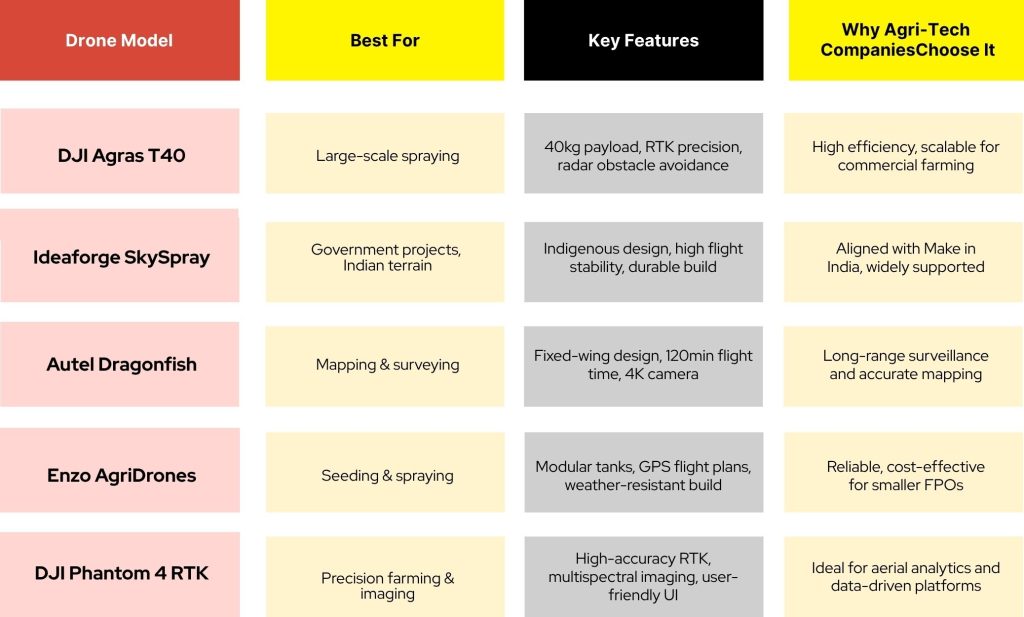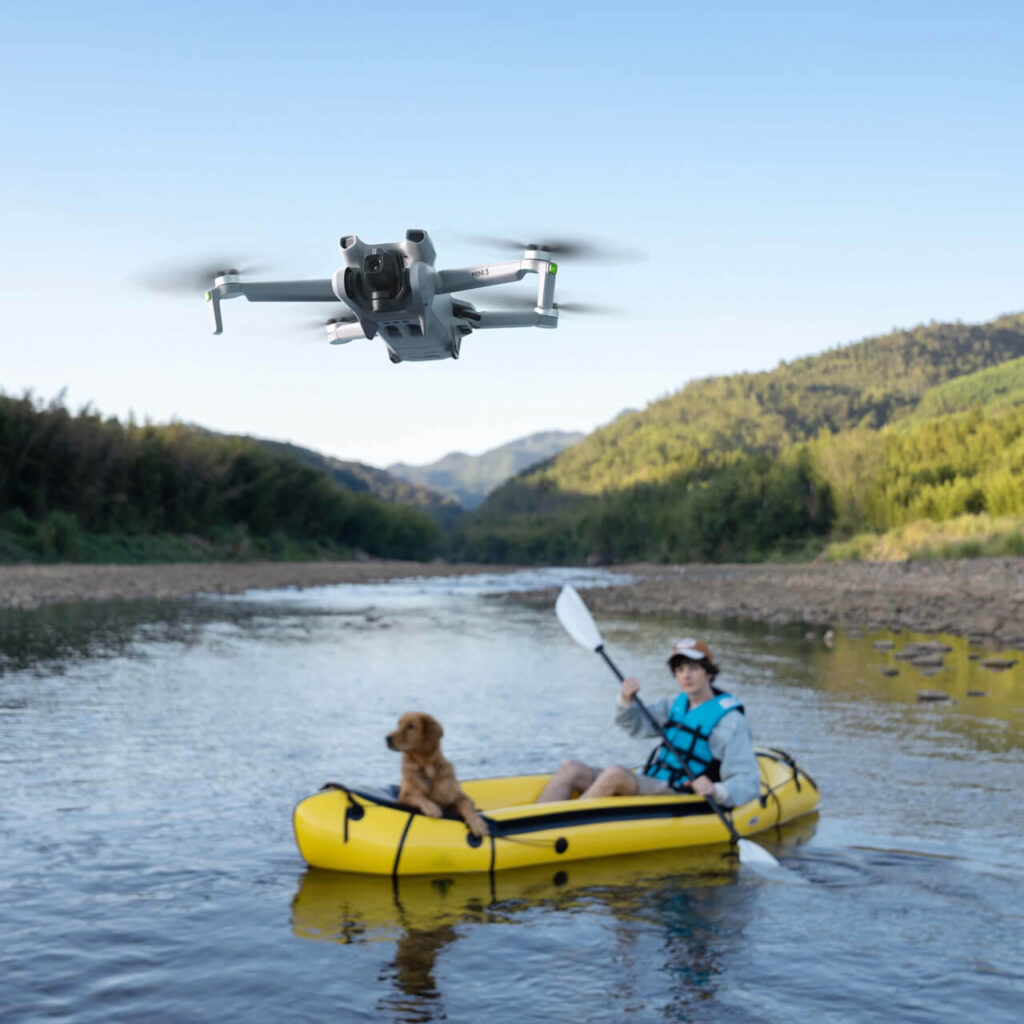For decades, Indian farming has struggled with age-old challenges unpredictable weather, labor shortages, low yields, and inefficient resource use. But a quiet revolution is taking root across the fields, and it’s flying a few feet above the crops.
Drone technology, once limited to defense or filmmaking, is now becoming the next big disruptor in agriculture. Whether it’s spraying crops, analyzing field health, or mapping large areas in minutes, drone-based farming solutions are reshaping how India grows its food.
But this shift isn’t driven by farmers alone. Agri-tech companies startups, tech giants, and forward-thinking agribusinesses are the real catalysts. They’re not just experimenting with drones; they’re investing in them, integrating them into their platforms, and offering drone-powered services to even the most remote villages.
This blog explores why and how agri-tech companies are betting big on drones, the challenges they’re solving, the real-world impact they’re creating, and the models driving this transformation.
Why Traditional Farming Needs a Tech Upgrade
India’s agriculture sector feeds over a billion people but still faces several deep-rooted problems:
Key Challenges:
- Over-dependence on manual labor, which is becoming scarce and expensive
- Low productivity per acre due to outdated practices
- Unpredictable weather, pests, and disease outbreaks
- Inefficient resource usage, especially in water and fertilizers
- Delayed decision-making from lack of real-time crop data
This is where technology steps in and not just any technology, but one that’s cost-effective, scalable, and easy to deploy across varied terrains. Enter drone-based farming solutions.
Drones offer speed, precision, and aerial intelligence all critical for modern farming. And as agri-tech startups race to solve these problems, drone integration is emerging as a top priority.
In fact, some experts argue that drones may even help solve India’s agricultural labour crisis, especially in remote regions with shrinking rural workforces.
Also worth noting: If you’re exploring drone use for agriculture or want to understand broader drone rules, you might also find it useful to read:
- Can I Fly My Drone Freely or Do I Need a License? Understand the Rules
- Can Drones Solve India’s Labour Crisis in Agriculture?
What Drone Technology Brings to Indian Agriculture
Agri-tech companies aren’t investing in drones just for the hype they’re doing it because drones solve real, on-ground problems with speed and precision.
Here’s what drone technology enables in Indian agriculture:
1. Precision Farming
Instead of spraying an entire field, drones can target specific zones with:
- Fertilizers
- Pesticides
- Water
This saves inputs and reduces chemical exposure a win for both productivity and sustainability.
2. Field Mapping and Surveying
High-resolution aerial maps help identify:
- Crop health variations
- Soil conditions
- Water stress zones
This kind of bird’s-eye data enables smarter decisions that were previously impossible at scale.
Want to know how this compares with traditional surveying? Check out:
Why Builders Now Trust Drones More Than Ground Teams for Site Surveys
3. Crop Monitoring with Aerial Imaging
Drones equipped with multispectral cameras provide insights on:
- Plant growth stages
- Pest infestations
- Nutrient deficiencies
That’s why many agri-tech platforms now integrate drone imagery with AI-powered dashboards.
Curious about the camera side of things? You’ll like:
How Cameras in Drones Are Transforming Construction, Farming, and Filmmaking in 2025
4. Spraying and Seeding Automation
Some drones are built for:
- Spraying pesticides over large areas in minutes
- Seeding operations for hard-to-reach zones or reforestation
Indian models like Ideaforge’s Agri Drones and international options from DJI are leading this trend.
5. Disaster Response and Insurance Surveys
After floods, droughts, or pest attacks, drones are used to assess crop loss quickly — critical for:
- Fast-tracking insurance claims
- Planning re-sowing strategies
- Evaluating disaster impact on a district-wide scale
Why Agri-Tech Companies Are Investing in Drones
From startups to established agribusiness platforms, agri-tech players are actively building drone tech into their solutions and it’s not just about innovation for the sake of it. The investments are strategic, scalable, and profit-driven.
Here’s why the shift is happening now:
1. Drones Align with the Precision Agriculture Model
Modern farming is moving from blanket methods to data-backed micro-decisions. Drones support this by:
- Reducing wastage in spraying and irrigation
- Providing near-instant crop health analytics
- Optimizing yield forecasts
This helps agri-tech platforms offer farm advisory services that go beyond guesswork.
2. Growing Government Push and Subsidies
Initiatives like India’s Drone Shakti and Kisan Drones have created a favorable environment. Companies can now:
- Collaborate with government schemes
- Offer drone services to FPOs (Farmer Producer Organizations)
- Tap into subsidy-based sales models
Related read: Can You Import a Drone from China to India? Here’s the Truth
3. Drones Are Cost-Efficient at Scale
For large farms and contract farming models, drones:
- Cover more land in less time
- Reduce labor costs significantly
- Offer repeatable, automated results
This is exactly why companies prefer deploying fleet-based drone services in partnership with agronomists or local drone pilots.
4. Easy Integration with Agri-Tech Platforms
Today’s leading drone models come with:
- Remote controllers (RCs)
- AI-assisted flight modes
- Cloud-based data export
This enables seamless connection with mobile apps and farm dashboards. And if you’re wondering what RCs really offer, here’s a helpful resource:
What Is a Remote Controller RC in Drones? Top Picks for Agriculture, Construction & Creators
5. Drones Give Agri-Tech Companies a Competitive Edge
For many agri-tech startups, drones are a differentiator. Whether it’s:
- Remote farm management
- Field trials and demos
- Analytics for precision input
the ability to offer aerial tech attracts both farmers and investors.
Real-World Use Cases and Success Stories
Agri-tech companies across India are already proving that drone-based farming solutions aren’t futuristic ideas—they’re real, practical, and delivering results today.
Here are some standout examples of how drones are transforming Indian fields:
1. Precision Spraying in Punjab’s Wheat Belt
A leading agri-tech startup partnered with a fleet of DJI Agras drones to:
- Spray fertilizer across 500+ acres in Amritsar and Ludhiana
- Cut spraying time by 70%
- Reduce chemical use by 30%, saving farmers significant costs
Farmers reported fewer cases of over-spraying and leaf burns — something almost impossible with manual application.
2. Crop Health Mapping in Telangana
A drone service provider worked with an agri-analytics company to survey cotton fields using multispectral drones. They:
- Identified pest stress early
- Helped deploy biological controls on time
- Increased cotton yield by nearly 12% over untreated plots
These insights also helped local FPOs negotiate better rates with bulk buyers.
Curious how drones detect crop health? Learn more in
How Agriculture Drones Are Transforming Indian Farms: A Guide to the Top Models in 2025
3. Rice Seeding by Drone in Assam’s Wetlands
Agri-tech teams deployed Enzo spraying drones for wetland paddy seeding. Traditional transplanting in those areas was:
- Labor-intensive
- Slow
- Limited by accessibility
With drone broadcasting:
- Seeding was done in under 3 hours per hectare
- Labor dependency dropped by 80%
- Germination rates remained high
Wondering if drone rules apply here too? You’ll want to check:
Why Your Drone’s Weight Decides What Rules You Follow
4. Insurance Claims via Drone Surveys in Maharashtra
After a hailstorm affected sugarcane farms near Pune, an agri-insurtech firm used Autel drones to:
- Survey affected farms within 24 hours
- Generate visual and mapped damage reports
- Process claims for over 300 farmers within a week
This kind of speed wouldn’t be possible with traditional inspection.
5. Government Collaboration in Uttar Pradesh
An agri-tech company supplied Ideaforge agricultural drones to a pilot program by the Department of Agriculture. Results included:
- Spray uniformity up to 92%
- Positive farmer feedback on safety and visibility
- Plans to scale deployment to additional 100 villages
Top Drones Powering Agricultural Transformation in India
Not all drones are created equal, especially when it comes to farming. Agri-tech companies in India are choosing their hardware based on payload capacity, flight stability, spraying efficiency, and smart sensors. Let’s break down the top models currently leading the charge.
Comparison Table: Leading Agriculture Drones in 2025

Why These Models Stand Out
- DJI models dominate for their smart safety features, which is great for beginners and institutions worried about damage or crashes.
- Ideaforge drones are trusted by Indian government bodies and agri-cooperatives. Their rugged builds and reliable support make them ideal for rural deployment.
- Autel drones serve dual purposes not just farming, but also land mapping, flood assessments, and even construction.
- Enzo drones are emerging as flexible workhorses for mid-scale farms and FPOs looking for spraying + seeding combo units.
Challenges and the Road Ahead
Despite strong momentum, drone-based farming in India still faces a few critical roadblocks. Agri-tech companies are aware of these, and many are already working on solutions.
1. Regulatory Uncertainty
- Not all drone models are approved for agricultural use.
- Licensing rules can be confusing, especially for first-time buyers or rural operators.
For clarity, refer to:
Can I Fly My Drone Freely or Do I Need a License? Understand the Rules
2. High Initial Costs
While drones save money long-term, many smallholder farmers find the upfront cost unaffordable.
Agri-tech companies are solving this through:
- Rental programs
- Drone-as-a-service models
- Subsidy integrations
Read more:
Why More Creators and Surveyors Are Renting Drones Instead of Buying
3. Lack of Skilled Operators
Operating a drone for field spraying or imaging requires training. Many rural areas still lack:
- Certified drone pilots
- Local drone repair services
Some platforms now offer operator onboarding, remote support, and multi-language flight app interfaces.
Curious about drone accessories and controllers? See:
What Is a Remote Controller RC in Drones? Top Picks for Agriculture, Construction & Creators
4. Connectivity Issues in Rural Areas
Data syncing, RTK positioning, and app-based flight planning can require good mobile internet something many remote regions still lack.
Solutions include:
- Offline mission planning
- Edge computing devices
- Partnerships with telecom providers
5. Climate and Terrain Variability
Drones need to handle:
- Extreme heat in Rajasthan
- Wetlands in Assam
- Hills in Uttarakhand
That’s why custom models like Enzo AgriDrones or Ideaforge platforms are built for rugged, Indian conditions.
Frequently Asked Questions (FAQs)
1. Do I need a license to fly a drone for agriculture in India?
Yes, if your drone weighs more than 250 grams, you’ll need to:
- Register it on the Digital Sky platform
- Get an Unmanned Aircraft Operator Permit (UAOP) for commercial use
- Fly only in permitted zones, with remote pilot certification
2. Are agriculture drones difficult to operate?
Modern drones like the DJI Agras T40 or Enzo AgriDrones are designed for simplicity. With:
- Pre-planned flight routes
- Auto take-off/landing
- Obstacle avoidance
Even beginners can operate them after a short training period.
3. Can smallholder farmers afford drones?
The drone itself may seem expensive, but many agri-tech companies now offer:
- Rental services
- Drone-as-a-service models
- Access through Farmer Producer Organizations (FPOs)
These models make it affordable even for 1–2 acre farms.
4. What drone should I choose for spraying or mapping?
That depends on your use case:
| Use Case | Recommended Model |
|---|---|
| Spraying (large) | DJI Agras T40 |
| Spraying (small) | Enzo AgriDrones |
| Mapping/Survey | DJI Phantom 4 RTK, Autel |
| Government use | Ideaforge SkySpray |
5. What if my drone gets damaged or is refurbished unknowingly?
- Always buy from a trusted seller like Jetayu Gadgets
- Ask for the original box, invoice, and registration number
- Use verified marketplaces with return policies



